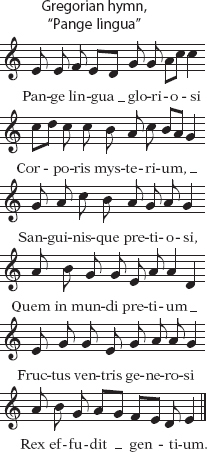Josquin Desprez (c. 1450–1521), Pange lingua Mass (c. 1510)
The first master of the High Renaissance style was Josquin Desprez. Like Dufay, he was born in the north of France, and like Dufay and many other of his countrymen, in early life he traveled to Italy. The list of Josquin’s patrons reads like a Renaissance who’s who: Pope Alexander VI, the notorious Sforza family of Milan, the Estes of Ferrara, Louis XII, king of France.

An amazingly imaginative composer, Josquin brought the fifteenth-
Josquin wrote eighteen different settings of the Mass — all large pieces in the standard five-
This is a four-
We shall examine the first two sections of Josquin’s Pange lingua Mass.
Kyrie The men in the choir sing line 1 of the hymn “Pange lingua,” in simple monophony, before the first section of the Pange lingua Mass. This first section, the Kyrie, is an elemental prayer consisting of three subsections:
| Kyrie I: | Kyrie eleison. | Lord have mercy. |
| Christe: | Christe eleison. | Christ have mercy. |
| Kyrie II: | Kyrie eleison. | Lord have mercy. |
For Kyrie I, Josquin wrote a point of imitation — a brief passage of imitative polyphony usually using a single melodic motive. Here the motive is a paraphrase (see page 60) of line 1 of the hymn:


This motive enters many times in the various voice parts, sometimes with delays in between: tenor, bass, wait, soprano, alto, wait, bass, tenor, soprano. Josquin did not invent this motive — it was derived from the plainchant hymn, as shown above — but his paraphrase is very beautiful, especially at the end.
The Christe section has two points of imitation, also derived from the hymn, for the words Christe and eleison; the motives of these points are rhythmically similar. Kyrie II has a new point of imitation for the words Kyrie eleison, followed by free material not paraphrased from the hymn — a descending sequence and, prior to the drawn-
LISTEN
Josquin, Pange lingua Mass, Kyrie
| 0:09 | Kyrie eleison. | Lord have mercy. |
| 0:53 | Christe eleison. | Christ have mercy. |
| 2:10 | Kyrie eleison. | Lord have mercy. |
Gloria The four remaining sections of the Mass — the Gloria, Credo, Sanctus, and Agnus Dei — introduce countless new points of imitation, which are interspersed with occasional passages of homophony.
In the second subsection of the Gloria, beginning with the words Qui tollis, polyphony and homophony are contrasted in a highly expressive way. At the beginning, we can almost envisage one or two persons timidly invoking Him “who takes away the sins of the world” (polyphony), and then the whole congregation — or, symbolically, the whole of Christendom — urgently responding together with a plea for mercy and relief: “have mercy” (homophony). This music gives a dramatic sense of communal worship.
The “Qui tollis” subsection as a whole includes eight points of imitation and four homophonic or nearly homophonic phrases. (The imitation on “Tu solus Dominus” is illustrated on page 64.) Even in the imitative phrases, the vocal lines fit together smoothly into chords, and while the sequence of these chords seems hard to predict, at least for modern ears, it does not seem arbitrary. The remarkable mood of Josquin’s music — at once sober, quietly energetic, and reverential — owes much to its Phrygian (E) mode. Like the hymn “Pange lingua,” the Pange lingua Mass is in this mode.
LISTEN
Josquin, Pange lingua Mass, from the Gloria
|
Capital letters indicate phrases sung in homophony. |
||
| 0:00 | Qui tollis peccata mundi, MISERERE NOBIS. | You who take away the sins of the world, have mercy upon us. |
| 0:34 | Qui tollis peccata mundi, SUSCIPE DEPRECATIONEM nostram. | You who take away the sins of the world, hear our prayer. |
| Qui sedes ad dexteram Patris, miserere nobis. | You who sit at the right hand of the Father, have mercy upon us. | |
| 1:18 | Quoniam tu solus sanctus, tu solus Dominus, tu solus altissimus, Jesu Christe, | For you alone are holy, you alone are the Lord, you alone are the most high, Jesus Christ, |
| cum sancto spiritu, in gloria Dei Patris. | With the Holy Spirit, in the glory of God the Father. | |
| AMEN. | Amen. | |